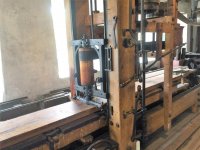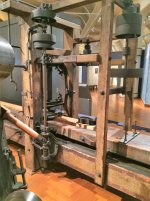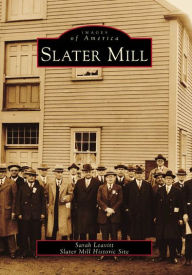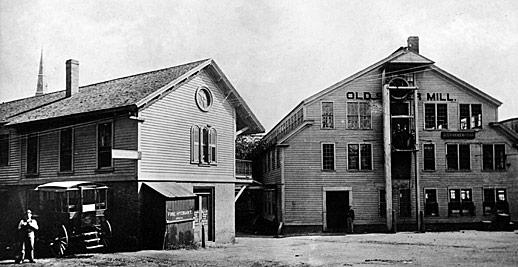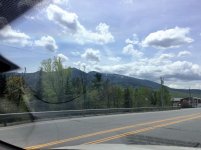G&L4nahalf
Cast Iron
- Joined
- Jul 27, 2014
- Location
- Temporarily Florida
Greetings PMers
Well I finally got to do it. Visit David Wilkinson's machine shop, very plausibly reconstituted from his time period 1790 to ~1840. It is formally known as the Wilkinson Mill Museum. Before I left to visit it, I could find very little about the machine shop posted on PM. I also visited the American Precision Museum in Windsor Vt, and the Ford in Detroit.
David's shop is located just a few streets from Interstate 95, in Pawtucket Rhode Island, a part of Providence. Anyone planning to go, be prepared to use GPS to find it, because the simple sounding directions from the official Inet site are not simple, except maybe for the locals.
Some time before I left Florida, I made special arrangements with the museum to extensively measure and photograph the machinery. Which request they most generously granted, and on Sat May 27th 2017, we were treated to an extensive after hours private tour with the machinery under power.. I have very many pictures that I would like to include in this thread, along with much measurements of some of the machinery, and much information.
The water-wheel power has been very faithfully reconstructed from the ancient drawings, and is an under-shot putting out better than 30 raw hp to the belting to the machinery. It is complete including a governor. It makes the building thunder. I have a number of good pictures plus some short movies showing the wheel in action.
David Wilkinson Mill, Pawtucket RI
David Wilkinson's water-wheel
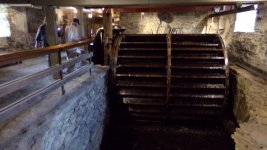
A small part of the shop

My baby ... She is 124 1/4" long, 22" wide, and 48" to the top of the head-stock pulley. The large hand-wheel used to push the tool carriage toward the tail-stock via an internal toothed rack (not room to attach it where she's positioned because at the end of the feed stroke the rack extends quite a bit out of the front of the Engine Lathe) is 22 3/4" dia and covered with a 3/8" thick leather band nailed to the outer part of the wooden part of the wheel. I have seen some 100 year old leather in my time, but this is at least twice as ancient as what I've seen. I have a number of additional high-def pictures taken from different angles, including inside the wooden bed. She has to be the oldest known engine-lathe in the USA, and I would like to date her to about 1798-1799.

Words cannot adequately express my thanks and gratitude to the staff of the Wilkinson Museum complex, and most especially Carl Johnson, the resident engineer-curator; who has made all this possible. But a heart-felt thank you, Carl.
PMers enjoy, and I hope I will be allowed to present much more, George
Well I finally got to do it. Visit David Wilkinson's machine shop, very plausibly reconstituted from his time period 1790 to ~1840. It is formally known as the Wilkinson Mill Museum. Before I left to visit it, I could find very little about the machine shop posted on PM. I also visited the American Precision Museum in Windsor Vt, and the Ford in Detroit.
David's shop is located just a few streets from Interstate 95, in Pawtucket Rhode Island, a part of Providence. Anyone planning to go, be prepared to use GPS to find it, because the simple sounding directions from the official Inet site are not simple, except maybe for the locals.
Some time before I left Florida, I made special arrangements with the museum to extensively measure and photograph the machinery. Which request they most generously granted, and on Sat May 27th 2017, we were treated to an extensive after hours private tour with the machinery under power.. I have very many pictures that I would like to include in this thread, along with much measurements of some of the machinery, and much information.
The water-wheel power has been very faithfully reconstructed from the ancient drawings, and is an under-shot putting out better than 30 raw hp to the belting to the machinery. It is complete including a governor. It makes the building thunder. I have a number of good pictures plus some short movies showing the wheel in action.
David Wilkinson Mill, Pawtucket RI

David Wilkinson's water-wheel

A small part of the shop

My baby ... She is 124 1/4" long, 22" wide, and 48" to the top of the head-stock pulley. The large hand-wheel used to push the tool carriage toward the tail-stock via an internal toothed rack (not room to attach it where she's positioned because at the end of the feed stroke the rack extends quite a bit out of the front of the Engine Lathe) is 22 3/4" dia and covered with a 3/8" thick leather band nailed to the outer part of the wooden part of the wheel. I have seen some 100 year old leather in my time, but this is at least twice as ancient as what I've seen. I have a number of additional high-def pictures taken from different angles, including inside the wooden bed. She has to be the oldest known engine-lathe in the USA, and I would like to date her to about 1798-1799.

Words cannot adequately express my thanks and gratitude to the staff of the Wilkinson Museum complex, and most especially Carl Johnson, the resident engineer-curator; who has made all this possible. But a heart-felt thank you, Carl.
PMers enjoy, and I hope I will be allowed to present much more, George






